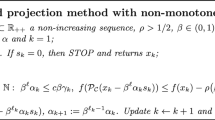Abstract
One of the main drawbacks of the subgradient method is the tuning process to determine the sequence of steplengths. In this paper, the radar subgradient method, a heuristic method designed to compute a tuning-free subgradient steplength, is geometrically motivated and algebraically deduced. The unit commitment problem, which arises in the electrical engineering field, is used to compare the performance of the subgradient method with the new radar subgradient method.
Similar content being viewed by others
References
D.P. Bertsekas (1999) Nonlinear Programming EditionNumber2 Athena Scientific Belmont, Massachusetts
D. G. Luenberger (1984) Linear and Nonlinear Programming EditionNumber2 Addison-Wesley, Reading Massachusetts
J.B. Hiriart-Urruty C. Lemaréchal (1996) Convex Analysis and Minimization Algorithms. Springer Verlag Berlin, Germany
N.Z. Shor (1998) Nondifferentiable Optimization and Polynomial Problems, Nonconvex Optimization and Its Applications. Kluwer Academic Publishers Dordrecht Holland
S. Feltenmark (1997) On Optimization of Power Production Department of Mathematics, Optimization, and Systems Theory. Royal Institute of Technology Stockholm, Sweden
J. E. Kelley (1960) ArticleTitleThe Cutting-Plane Method for Solving Convex Programs SIAM Journal on Applied Mathematics 8 703–712
S. Feltenmark K. Kiwiel C. Dual (2000) ArticleTitleApplications of Proximal Bundle Methods,Including Lagrangian Relaxation of Nonconvex Problems SIAM Journal on Optimization 10 697–721
Kiwiel, K. C., A Survey of Bundle Methods for Nondifferentiable Optimization, Proceedings of the 13th International Symposium on Mathematical Programming, Tokyo, Japan, 1988.
H. Schramm J. Zowe (1988) A Combination of the Bundle Approach and the Trust-Region Concept J. Guddat B. Bank (Eds) et al. Advances in Mathematical Optimization Akademie Verlag Berlin, Germany
H. Schramm J. Zowe (1992) ArticleTitleA Version of the Bundle Idea for Minimizing a Nonsmooth Function: Conceptual Idea, Convergence Analysis, Numerical Results SIAM Journal on Optimization 2 121–152
O. Du Merle J.L. Goffin et al. (1998) ArticleTitleOn Improvements to the Analytic Center Cutting Plane Method Computational Optimization and Applications 11 37–52
J.L. Goffin J.P. Vial (1999) Convex Nondifferentiable Optimization:A Survey Focused on the Analytic Center Cutting Plane Method Geneva University HEC, Logilab
J. Gondzio R.,. Sarkissian et al. (2001) ArticleTitleParallel Implementation of a Central Decomposition Method for Solving Large-Scale Planning Problems Computational Optimization and Applications 19 5–29
A.S. Nemirovsky D. B. Yudin (1983) Problem Complexity and Method Efficiency in Optimization. John Wiley and Sons New York, NY
B. M. Baker J. Sheasby (1999) ArticleTitleAccelerating the Convergence of Subgradient Optimization European Journal of Operational Research 117 136–144
F. Barahona R. Anbil (2000) ArticleTitleThe Volume Algorithm: Producing Primal Solutions with a Subgradient Method Mathematical Programming 87 385–399
A. Nedic D. P. Bertsekas (2001) ArticleTitleIncremental Subgradient Methods for Nondifferentiable Oprimization SIAM Journal on Optimization 12 109–138
K. Kiwiel C.T. Larsson et al. (1999) ArticleTitleThe Efficiency of Ballstep Subgradient Level Methods for Convex Optimization Mathematics of Operations Research 24 237–254
C. Beltran F. J. Heredia (1999) ArticleTitleShort-Term Hydrothermal Coordination by Augmented Lagrangian Relaxation: A New Multiplier Updating Investigación Operativa 8 63–76
S. Lai R. Baldick (1999) ArticleTitleUnit Commitment with Ramp Multipliers IEEE Transactions on Power Systems 14 58–64
S.J. Wang S. M. Shahidehpour et al. (1995) ArticleTitleShort-Term Generation Scheduling with Transmission and Environmental Constraints Using an Augmented Lagrangian Relaxation IEEE Transactions on Power Systems 10 1294–1301
F. Pellegrino A. Renaud et al. (1996) ArticleTitleBundle and Augmented Lagrangian Methods for Short-Term Unit Commitment 12th Power System Computation Conference 2 730–739
C. Beltran F. J. Heredia (2002) ArticleTitleUnit Commitment by Augmented Lagrangian Relaxation: Testing Two Decomposition Approaches Journal of Optimization Theory and Applications 112 295–314
Beltran, C., Generalized Unit Commitment by the Radar Multiplier Method, PhD Thesis, Statistics and Operations Research, Polytechnic University of Catalonia, Barcelona, Catalonia, Spain, 2001; see http://www.tdcat.cesca.es/TDCat-0720101-132715/, 2001.
Author information
Authors and Affiliations
Additional information
Communicated by M. Simaan
This research was supported by the Spanish Government, CICYT Grant TAP99-1075-C02-01. We acknowledge the technical support from Logilab (HEC, University of Geneva) and especially the valuable remarks and suggestions of the referees.
Rights and permissions
About this article
Cite this article
Beltran, C., Heredia, F.J. An Effective Line Search for the Subgradient Method. J Optim Theory Appl 125, 1–18 (2005). https://doi.org/10.1007/s10957-004-1708-4
Issue Date:
DOI: https://doi.org/10.1007/s10957-004-1708-4




